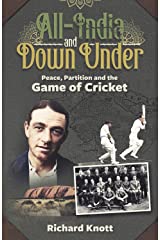All-India and Down Under: Peace, Partition and the Game of Cricket
Martin Chandler |Published: 2023
Pages: 256
Author: Knott, Richard
Publisher: Pitch
Rating: 3.5 stars

That no one writes, or at least no one publishes tour accounts anymore, is an observation I have made many times before. It seems to me that there are two reasons for this, those being firstly that we can all watch the action for ourselves these days, and secondly that in the twenty first century there aren’t really any tours any more anyway. Flying in and out of a country for a concentrated burst of international cricket is a far cry from the leisurely trips that in days gone by would take many weeks and involve a schedule of matches that would criss cross the country being visited and involve a great deal more than a series of Test matches.
But tour books still appear, the main change being that they have become retrospective looks at old tours and series that live on now only in books and, in some cases, a few precious fragments of newsreel film. This title tells the story of two tours from just after the war, the visit to England by what was then styled as All-India in 1946, and England’s hugely disappointing trip to Australia the following winter. Both were the subject of books at the time, in the case of the former by John Arlott and LN Mathur*, and the latter by Bruce Harris, Clif Cary and Denis Compton, but neither tour has been fully examined since.
Occasionally the retrospective tour account is much the same as the sort of book that might have been published at the time. The story is compiled from contemporary reports and, if the author has not gone too far back in time, can be supplemented by the thoughts of those who were there and saw the action unfold. In the case of 1946 and 1946/47 Knott does not have that luxury, other than in the form of the autobiographies of those involved, so a straightforward account would not add much more than a bit of hindsight to the accounts published at the time.
Wisely in the circumstances Knott has not attempted to confine himself to a cricketing history book and a look through his sources demonstrates the breadth of his research. All the cricket books that I expected to see are there, but also present are a number of works of general history and social history. The result is an absorbing read that puts the two tours firmly in the context of the parlous state of the UK economy at the time and, following on from that. the new world order and the pressing need for the UK to grant independence to India.
The story Knott tells is largely one that is set out chronologically, although it does digress from time to time in order to provide context for the post war state of the world and of English cricket. Contained in the narrative are the stories of many of the men who feature, most notably the three captains involved, Hammond, Bradman and Pataudi, but almost all of those who played even a minor role in the events that unfolded get something by way of an introduction, the only notable omission from that being the Indian all-rounder CS Nayudu. To be fair to Knott other than in defeat against Yorkshire Nayudu’s contributions to the tour were negligible, but given the extent to which he disappointed and in order to make it clear to the less knowledgable that he should not be confused with his illustrious older brother, I would have thought a nod to his back story would have been useful.
But that is one minor grumble about a story that I much enjoyed reading. There are no great revelations in the book, but in the absence of some new archive material there were never going to be and that is no reason not to, as Knott has most skilfully done, save anyone interested in these two tours from having to assemble all of the source material themselves. The book also contains a bit of fiction, and a rather nice touch in that Knott writes up reports for the Indian team manager on the 1946 tour, and for Hammond on the 46/47 one. Both are entertaining, and whilst no such document exists from Pankaj Gupta, it would have been interesting to know how the Hammond document compares with the real thing.
In terms of its production the book is attractively designed and put together and has an excellent index. One thing it does lack however, surprisingly, is any information about author Richard Knott, although a quick google search resolved that one for me. Knott is a historian and (several times) previously published author. This explains why the book is so well written and, whilst All-India and Down Under: Peace, Partition and the Game of Cricket is Knott’s first on cricket, let us hope there are more to come.
*I have never read Mathur’s book, and I suspect Knott hasn’t either as it is not mentioned in his bibliography. I do however know that Mathur was not one of the three Indian journalists who were in England in 1946, so his account can only be an ‘ear witness’ one at best.






Leave a comment